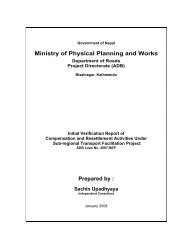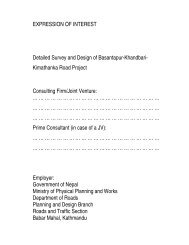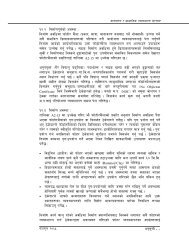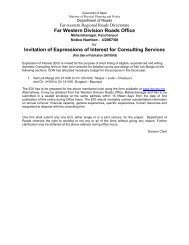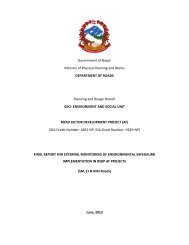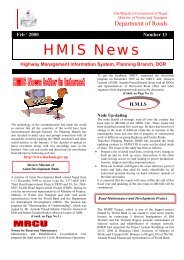Environmental & Social Management Framework - About ...
Environmental & Social Management Framework - About ...
Environmental & Social Management Framework - About ...
You also want an ePaper? Increase the reach of your titles
YUMPU automatically turns print PDFs into web optimized ePapers that Google loves.
<strong>Environmental</strong> and <strong>Social</strong> <strong>Management</strong> <strong>Framework</strong>- Quarry and borrow pit location shown in design documents are providedonly as a guide. It is the Contractor’s responsibility to verify the suitabilityof all material sources, and to obtain the approval of the Engineer. Ifpossible, seek borrow pit locations not immediately adjacent to the roadshoulder.- The sustainable rate and total amount of extraction from the sites shouldbe assessed.For both quarries and borrow pits, locations should be selected inconsultation with local residents and water users and ensure thatirrigation intakes, water intakes, bunds and local fishing areas andactivities are not adversely affected.- Educate local communities not to use abandoned quarries and borrowpits as garbage dump sites, and alert them on the inherent health riskswhen doing so.• Mitigative Measures:- Extraction of sand and stone from seasonal rivers should be avoided dueto the impact on complex flood hydrology, which can result in much moreserious storm floods.- Extraction of stone and sand should be spread over the longest lengthpossible so that no section of river bed is excessively disturbed;- Clearing of trees and other desirable vegetation should be discouraged.Only those trees which are absolutely necessary to operate the sitesshould be cleared;- If clearing of trees is needed, then the cost of replanting and maintenancefor a 12-month period should be included in the Bill of Quantities. As analternative, the contract for replanting and maintaining the trees can beawarded to local communities, people or NGO;- Stripped material shall be stored so as to not disrupt natural drainage andshall be protected to prevent erosion and migration of soil particles intosurface water.- Temporary ditches and / or settling basins should be dug to collect runoffwater and to prevent erosion and contamination of surface water;- The undesirable ponding of water shall be prevented through temporarydrains discharging to natural drainage channels;- In case ponding takes place, at the time of decommissioning the site,insecticide spraying may be considered to combat water-borne diseasevectors.- Extraction locations should not be near bridge and river trainingstructures;- Location of extraction should be selected where there is little fine materialto be carried downstream;- The site should be restored after completion of construction activities, andleft in stable condition without steep slopes;- If possible the sites should be filled, final surface should be graded toprovide surface water drainage, stripped material should be spread tostable contours in order to promote percolation and re-growth of naturalvegetation, and also planted with vegetation to provide protection againstinstability, erosion and scouring;- The restored site should be drained, and no standing water shall remain.Stagnant waters become disease vectors breeding site and pose threat topublic health;- The sites must always be closed and restored in a planned andappropriate manner to suit local conditions and in consultation with theconcerned owners and/or community. It should be done before spreadingequipment is allowed to leave the site;- Apply proper fencing so nobody can deposit garbage and other wastematerial in the decommissioned sites.Chapter 6-8 April 2007



![j:6 ]zg cfof ]hgf](https://img.yumpu.com/51286794/1/190x245/j6-zg-cfof-hgf.jpg?quality=85)

![x'nfsL /fhdfu { cfof ]hgf](https://img.yumpu.com/50581959/1/190x245/xnfsl-fhdfu-cfof-hgf.jpg?quality=85)
